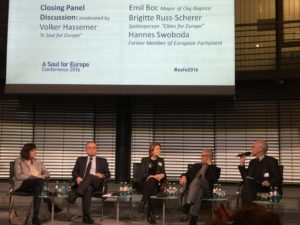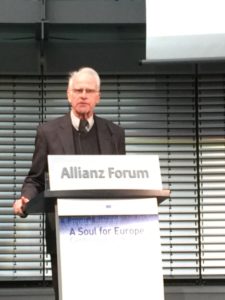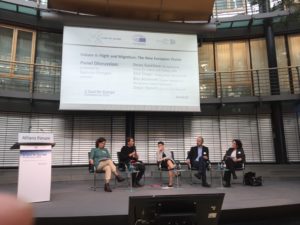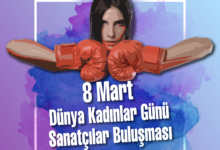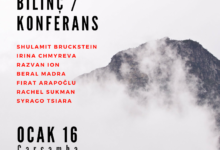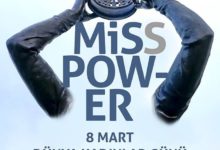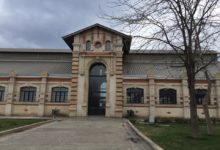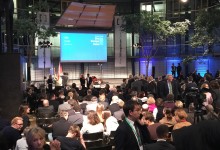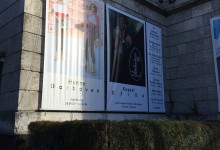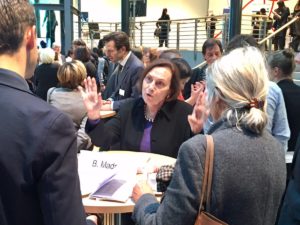
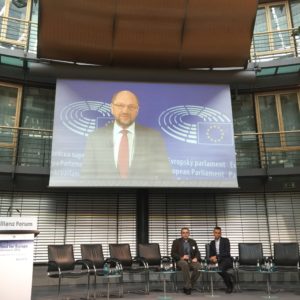
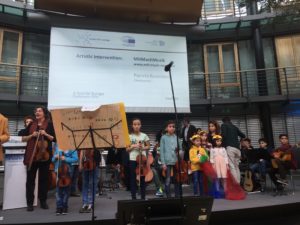
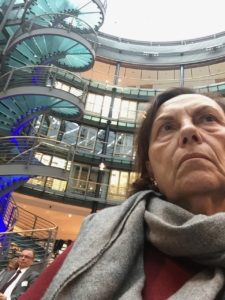
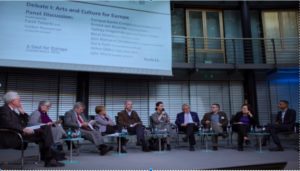
Invitation to the A Soul for Europe Conference 2016 8 and 9 November in Berlin
|
Tuesday, 8 November “Cultural Identities On The Move – New Responsibilities For The Cities”
|
|
Welcome address Markus Nitsche, Allianz Deutschland
Opening/Introduction Brigitte Russ-Scherer, Mayor a.D. / Spokesperson “Cities for Europe” Opening Words Hella Dunger-Löper, State Secretary, Commissioner of European Affairs of Berlin Opening Words Richard Kühnel, Representative of the European Commission in Germany The Cultural Divide in Europe – Can the European Project still be saved? Oliver Jens Schmitt, Historian, Professor at University of Vienna How do European Cities meet the Current Challenges? –Two statements from European cities Emil Boc, Mayor Cluj-Napoca Wouter van der Heijde, Senior Advisor on European Affairs, City of Amsterdam Marketplace – What To Do For Europe? – Presentation Of Cities And Projects Idea Camp, Cafébabel – the European Online Magazin, Route 28, Europa Lichtinstallation The Cities And Europe – What Needs To Be Changed? – Strategical attempts to strengthen the European project Arts Of Impact, Amsterdam / Berlin-Forum, Berlin |
|
Workshops / Participatory Debates
1. Civil Society, Participation and Urban Development 2. Culture, Integration, Plurality 3. Cities and Structures Closing panel discussion Emil Boc, Brigitte Russ-Scherer, 1 project moderated by Volker Hassemer |
|
Wednesday, 9 November
Welcome by Nele Hertling, A Soul for Europe
Opening/Introduction: Representatives of all partners state their European commitment
Debate I: Arts And Culture For Europe
A positive European self-confidence should be guided by its democratic achievements against the hostile, partially racist and populist movements that are increased by the refugees’ crisis, but also have other causes. Arts and Culture in particular convey another visionary image of Europe that needs to be upheld against those who refuse and fight against it. Cultural activities can and must help to convey tolerance and mutual understanding in an acceptable way. Debate II: Flight and Migration: The New European Divide
While the so-called “refugee crisis” continually polarises societies in the West, it unites them in the East in their rejection of Brussels’ policies. The European motto “unity in diversity” is meeting with fierce resistance by right-wing populist governments, who are offering national-religious narratives instead. But what is intended by those who create a climate of fear and suspicion towards migrants and refugees? How can a new European divide along the former Iron Curtain be overcome and how can artists and cultural producers contribute to a greater European awareness? Input: Rita Süssmuth Panel discussion: Dessy Gavrilova, Jacques Rupnik, Aleš Šteger, Rita Süssmuth Moderated by Hanno Gundert Debate III: Starting From The Bottom-up Debate IV: “15 Minutes Of Conversation With” on the Conference Topic
Speakers of the conference and other committed Europeans will be ready to share their practices, tools and reflections with the audience. A session to create a space for participants to learn, share and exchange inspiring experiences and ideas in small groups. With Cornelius Adebahr, Hubertus von Amelunxen, Enrique Barón Crespo, Paul Dujardin, Rose Fenton, Ulrike Guérot, Beral Madra, Paul Spies, Hannes Swoboda |
In 1980, after the third Military coup and after I have witnessed the implicit fascism behind a screen of democracy I decided to work in contemporary art, as it seemed one of the most freedom promising field. What I am witnessing and experiencing in Turkey now is not new, it is an accumulation and resurgence of socio-political evil and darkness.
Indeed since 1980’s the practice, circulation and propagation of contemporary art production in Turkey is very dissident and almost rebellious. The contents may be subjective but strongly political.
- The artist takes his/her inspirations and material directly from socio-political agenda, from the every-day dilemmas, from the margins of the city-life, from the phantoms of personal conscious and unconscious.
- Typology and classification is difficult, since there are numerous artistic methodologies and strategies; sometimes customary, sometimes complex.
- There are no boundaries between the techniques, between high and low, between traditional and the popular, between exotic and composed.
- The artists are presenting the public a multiplicity of perspectives to see the world by guiding them not only through the macro politics but also from the micro familiar grounds.
- The psycho-social and cultural connections between the artist and the public became the topic of art criticism which is practiced interdisciplinary by a large group of academicians, art and culture experts.
- Since 1990’s the artists were invited to EU art institutions and transported through their metaphoric works the socio-political dilemma and the every-day life of Turkey to be viewed by EU publics.
- From an idealist perspective, throughout the last 40 years contemporary art production dealing with the realities of Turkey’s past and present history cultivated the gaze of the people in Turkey and EU towards a reciprocal understanding. It activated changes in the perception and appreciation of the EU public not only towards Turkey but through Turkey to the non-EU societies with Islamic convictions.
- EU cultural policy with its funds and strategies for enlargement provided a constructive tool for the one’s who know how to utilize it.
Since a couple of years, Ingo Arend, one of the prominent journalists of Berlin who has profound knowledge on the contemporary art scene in Turkey has been informing the German speaking public with his essays and interviews. When we read his articles we can see that at the beginning he was quite optimistic and expectant; however lately he has seen the deficits and difficulties caused by infrastructural and political obstructions.
Let me briefly list the current complications that are shadowing the brilliant production that is supporting and disseminating the significance of freedom of expression during today’s adversary politics:
-Official cultural policy administrated by the Ministry of Culture and Tourism in tune with the AKP government’s political status quo is extremely distanced from contemporary art productions and activities. The AKP municipalities are also following the dictums and politics of the government.
-Local Government policy depends on the policy of its political party policy. Istanbul has 40 districts and 26 of them have AKP municipalities that obediently follow the culture policy of the government in the programs of existing 20 culture centres. With and objective approach one can say that these centres, with their free admittance fulfil the requirements of the lower middle-class population and somehow has a therapeutic role against the hegemony of television.
-The administration and programming of official and local government culture nd art policies are quite stagnant and far from renewing its content and form.
-Private enterprise in contemporary art started in early 80’s and gained undisputed upper hand in culture industry, so that now the private sector investment (private museums and art centers) are creating a strong monopoly.
These main components of the culture and art industry in Turkey focus to their own interests; they are not intending to update their policies towards supporting the creative individual in its quest for sustainable production and creating a strong network of art and culture institutions in Turkey and abroad.
However there is a common interest too, namely Neo-liberal economy parameters, that expects high income from culture industry and nourish the desire of the society of spectacle.
The difference in their interests is the strategies they are employing to reach their goal; the official culture policy is acting with Modernist strategies to control the content and form of the productions and activities whereas the private sector is utilizing the more subtle methods of manipulating the production.
The third sector consists of artists and art experts and individual gallery owners, who are making the art production and dissemination possible. These investments are provided mainly with their own resources, partly with generous sponsors. There are no official funds for contemporary art projects. Official funds are allocated for cinema, theatre and social projects with strong control of content and aesthetics. This sector is the main creator of dissident and provocative art production.
Focusing to censorship in art and cultural events, this website listed all recent censorship in Turkey .http://www.siyahbant.org/category/vakalar/page/6/.
We can discern two kinds of censorship: Direct censorship mostly activated by officials and official institutions and indirect censorship inflicted by private sector art and culture entities. Direct censorship is a PR deficit for private sector; therefore they create a kind of legal or economic reason to cover the censorship. What is dangerous now for creative individuals is hypocrisy; that is aiming to be independent and free, while being forced to collaborate with the official or private financial sources.
Pelin Başaran has opened a website: www.siyahbant.org and published a guide for artistic freedom of expression.
We have briefly analysed the current situation in contemporary art. Now the question is what to do to make it sustainable?
- EU contemporary art scenes, institutions, galleries, museums, artists art critics and curators should continue to communicate and collaborate with their counterparts in Turkey
- EU funds should open special sections for projects and scholarships and residencies which will help young generations artists to continue practice and make their works visible
- Collateral theoretical activities such as conferences, seminars, workshops should be frequently organised.

